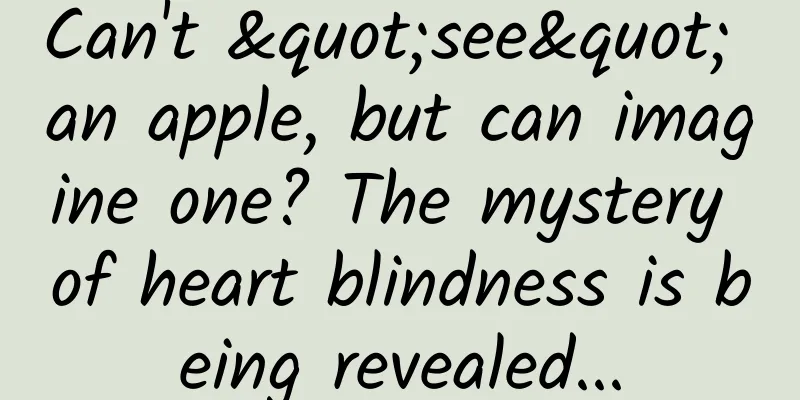Can't "see" an apple, but can imagine one? The mystery of heart blindness is being revealed...

|
Leviathan Press: Of course, we know that when you close your eyes and imagine an apple, it is impossible for your brain to "see" the apple. However, if we don't use the word "see" to describe it, how should we describe that image? Therefore, it is very likely that, whether you are a patient with heart blindness or not, your expression of the image of the apple is different from that of others. I have tried many times, and when I close my eyes and imagine an apple, I "see" a green apple, but the strange thing is that it is also vague and seems to exist and not exist. So, my confusion is, for those who claim to be heart-blind, are the images expressed through language the same as the actual images in their brains? Two years ago, Sarah Shomstein realized she didn’t have a “mind’s eye.” The vision scientist was sitting in a conference room listening to a scientific talk in which the speaker asked the audience to imagine an apple. Shomstein closed her eyes and did so. Afterward, the speaker asked the audience to open their eyes and rate how vividly they imagined the apple in their mind’s eye. Did they see the apple? Shomstein was confused. She didn’t actually see the apple. She could imagine the taste, shape, color, and the way light hit it. But she didn’t see it. Behind her eye, Shomstein recalls, “it was completely black.” Yet, “I imagined an apple.” Most of her colleagues had different reactions. They reported that they did see an apple, either clearly or blurrily, floating in front of them like a hologram. © Matteo Giuseppe Pani At that moment, Shomstein, who had studied perception for years at George Washington University, realized that she experienced the world differently than other people did. She was one of a group of people — estimated to be between 1 and 4 percent of the population — who lack mental imagery, a phenomenon known as aphantasia. Although the phenomenon was described more than 140 years ago, the term mindblindness wasn't coined until 2015. It immediately caught the attention of many people interested in how imagination works. That included neuroscientists. So far, they've found that mindblindness isn't a disease—it's a different way of experiencing the world. Earlier research suggests that differences in connectivity in brain areas involved in vision, memory, and decision-making could explain differences in people's ability to form mental imagery. Many people with mindblindness dream about images and can recognize objects and faces, so their brains likely store the visual information— they just can't actively access it or use it to have imagery experiences. © Verywell Mind That’s just one explanation for mindblindness. In fact, people’s subjective experiences vary widely, and different subgroups of mindblindness may have their own neural explanations. Mindblindness and hyperphantasia (a state of having unusually intense and vivid mental images), which is the opposite of a phenomenon in which people report mental imagery that’s as vivid as reality, are actually two ends of a spectrum, with a myriad of internal experiences in between. “When we talk about what mental imagery is, we think we know what that means,” says Nadine Dijkstra, a postdoctoral researcher at University College London who studies perception. “But when you really dig into it, it turns out that everyone’s experience is very different.” That makes studying mindblindness, hyperphantasia, and other internal experiences difficult — but not inconceivable. The process by which the brain creates mental images can be described as "retrospective perception." When we perceive something in front of us, "we try to infer meaning from the image," Dijkstra said. Electromagnetic waves enter our eyes, are converted into neural signals, and then flow to the back of the brain to be processed in the visual cortex. This information then flows to the front of the brain and enters memory or semantic areas - the result of this process is that we know whether we are looking at a cat or a cup of coffee. "During imagination, we basically do the opposite," Dijkstra said. You first know what you want to imagine, such as a cat, and then information flows from the memory and semantic areas of the brain to the visual cortex, where the image is sketched out. However, this was a working model of visual imagination; much was still unknown about the process, such as where the mental imagery begins and the exact role of the visual cortex. These processes were not well understood at the time. In the early 2000s, a 65-year-old man walked into Adam Zeman's office. Zeman, now a neurologist at the University of Exeter, studies visual imagery. He listened as the patient described how he could no longer create images in his mind after heart surgery. Before, when he read a novel, he could see characters and scenes. When he lost something, he could imagine where it might be. After surgery, his mental stage was blank. © TIME There is growing evidence that the visual cortex is activated when people imagine or perceive something. Zeman wondered if his patients’ visual cortex was somehow deactivated. He had his patients lie in a functional magnetic resonance imaging (fMRI) machine, and Zeman showed them pictures of celebrities and then had them imagine those pictures. In the scans, the patients’ visual cortex lit up noticeably only when they saw the pictures. In a 2010 case study, Zeman described this phenomenon as “blind imagination” [1]. After the case was reported in Discover magazine, Zeman received messages from 20 other people who said that, like the patient, they could not imagine images in their minds. However, unlike the patient, these people could not be said to have lost their imagination because they never had this ability. Apparently, this is a relatively common experience. In 2015, Zeman consulted a friend who studied classicism to name this phenomenon. The friend suggested borrowing Aristotle's term phantasia (meaning "mind's eye") to describe this phenomenon, and the term "aphantasia" was born. Soon after Zeman’s team reported the new term,[2] the New York Times published a story about aphantasia, sparking a new wave of public interest.[3] Zeman has now received more than 17,000 messages from people who want to know more about whether they have or lack the mind’s eye. At dinner tables around the world, friends and family discuss whether they can imagine an apple. Philosophers use aphantasia as a reason to explore explanations of the mind. Art exhibitions showcase works created by people with extreme visual abilities. And scientists are coming up with new ways to study aphantasia as a window into how the imagination works. © Gourav Mohanty Studying mind blindness isn’t easy. How do you measure someone’s inner world? For years, research “was focused on proving that the condition exists,” Shomstein says. Early studies relied on participant reports—and they still do. The best-known test, the Vividness of Visual Imagery Questionnaire,[4] was created in 1973 to study the intensity of mental imagery, long before mind blindness was named. However, such tests rely on introspection and self-reported experiences, which has led some neuroscientists to question whether mind blindness is real. Given the ambiguity in how we describe our inner worlds, are the differences in reported visual imagery a linguistic disconnect? “It could be that we’re all actually experiencing the exact same apple; we’re just describing it differently,” says Rebecca Keogh, a cognitive neuroscience researcher at Macquarie University in Sydney, Australia. Keogh was working on her PhD under Joel Pearson, a professor of cognitive neuroscience at the University of New South Wales, when Zeman coined the term “mind blindness” in 2015. They were so intrigued that they eventually designed tests—one probing the brain’s ability to retain visual images, another measuring sweat and pupil responses to mental images—to confirm the existence of mind blindness. Their results suggested that “it’s not just a difference in what they report,” Keogh says. “There does seem to be some difference in how they experience it.” For Cornelia McCormick, a memory researcher at the University of Bonn in Germany, the idea that some people don’t have mental images is hard to accept. But then McCormick got curious. Knowing that mental imagery is so closely tied to memory, she began to wonder, how do these people remember their lives? To test this, she and her team scanned the brains of people who self-reported having and not having acardia as they recalled their personal memories. © Medical Xpress They found that people with acardia do tend to have weaker autobiographical memories and less activity in the hippocampus, which helps encode and retrieve such memories.[5] To their surprise, however, these people had more activity in their visual cortex than people with more typical visual imagination. McCormick speculates that the increased activity in the visual cortex may suppress the signals needed to extract mental images from environmental noise. A growing number of papers have also found that the visual cortex of people with mind blindness becomes active when they imagine something. Perhaps they are “able to access visual information but somehow are unable to integrate it into their subjective experience,” says Paolo Bartolomeo, a neurologist at the Paris Brain Institute. This hypothesis fits with the fact that most people with acardiac blindness can recognize objects and faces and that many see images while they sleep and dream. "They know what the dream images look like," Zeman said. But for some reason, they can't actively access this visual information. Zeman wanted to know what's going on in their brains. A few years ago, Zeman used fMRI to scan the brains of volunteers at rest. The scans showed that, when resting, people with psychopathy had weaker connections between the brain’s higher-level control center (the prefrontal cortex) and lower-level perception center (the visual cortex) than people with hyperphantasia.[6] This finding is broadly supported by a new study from Bartolomeo’s lab, which is currently under peer review. Bartolomeo and his team had participants lie in a brain scanner and actively imagine shapes, faces, and places. People with and without acardia activated similar areas of the brain. However, people with acardia showed a disconnect between the imaginary nodes in the prefrontal cortex and the fusiform gyrus: an area that Bartolomeo had identified several years earlier as involved in higher-level visual processing.[7] Taken together, the findings suggest that the connections between the visual centers of the brain and other integration areas are different in people with acardia than in those without acardia. “This is a good explanation for some subtypes of acardia,” says Bence Nanay, a professor of philosophical psychology at the University of Antwerp who studies mental imagery, but he says there could be other neurological explanations, too. This means there could be multiple types of acardia—there is indeed a whole spectrum of different people’s internal visualizations. People with acardia report a wide variety of experiences. Some can "hear" in their mind, while others cannot imagine sight or hearing. Some have excellent autobiographical memories, while most do not. Some have involuntary flashes of mental imagery. Many can dream about the images, but some cannot. Most people are born with mind blindness, though some develop it later in life. "Mind blindness is not a singular phenomenon," Nanai says. Nor is hyperphantasia. Some people with hyperphantasia conjure up mental images that seem to them as real as things they actually see. Hyperphantasia patients see images that are different from hallucinations, and they seem to know at the time that the images are not real. But that doesn't mean they don't feel real. A small number of people with extremely vivid imaginations are called maladaptive daydreamers. Some people choose to live in their imaginations rather than in reality, Dijkstra says. "They sit on their couches, they don't go out, they don't go to school, they don't see their friends, they don't go to work. They just imagine the whole life they want. Because to them, it feels as real as reality." Regardless of where the research on these extreme imaginations is at, scientists tend to agree on one thing: mind blindness and hyperphantasy are not diseases. People at either end of the spectrum don’t usually have problems navigating the world. Hyperphantasics are often good at describing things, Bartolomeo says. When asked how they could visually describe objects or people from memory in the absence of mental imagery, they’ll respond, “I just know it.” “It’s just a variation of the normal brain,” he adds. “Everything in humans has variations.” Not having mental imagery may even have benefits. “You might think that mindblindness is a terrible thing…it seems to imply a very impoverished mental life,” Nanai says. “But I actually think that if you have mindblindness, you actually have something to be happy about.” Imagery is often linked to mental health. People with mindblindness may be less prone to mental health problems characterized by vivid mental imagery, he says. Conversely, if you suffer from hyperphantasia, the risk may be increased. A lack of mental imagery does not necessarily mean a lack of imagination. Zeman has heard many artists claim to suffer from hyperphantasia. Shomstein considers himself a creative and imaginative person. Successful people, including novelist Mark Lawrence and software engineer Blake Ross (co-founder of the Firefox browser), have revealed that they suffer from hyperphantasia. "I think this is the closest to a real revelation I have ever had in my lifetime," Blake Ross wrote in a 2016 Facebook post discussing his personal discovery. He had always thought that the insomnia of "counting sheep" was just a metaphor. For many people, it can be shocking to discover that their perception of the world is different from that of others. Shomstein still can't believe that other people can open their eyes and imagine apricots with the real world as the background. "Doesn't this interfere with your daily life?" she asked. "I think they are weird, and they think I am weird." But in fact, everyone is weird, Nanai said. We are all on a spectrum between hyperphantasia and mind blindness. It is not only possible, but also very likely that you and the person you meet on the street have completely different internal experiences. © ProProfs “The world we see, smell, hear, and think about is all reconstructed,” Shomstein says. Even a common experience, a thought, a memory, or a simple image of an apple can look and feel very different in the arena of the mind. So, when you imagine an apple, what do you “see”? Original article/www.theatlantic.com/science/archive/2024/08/aphantasia-visual-imagination/679427/ This article is based on the Creative Commons License (BY-NC) and is published by tamiya2 on Leviathan The article only reflects the author's views and does not necessarily represent the position of Leviathan |
<<: Is it true that "a dragon gave birth to nine sons"? There is fossil "evidence" | Bolan Daily
>>: Smart masks are here! Make breathing more "smart"
Recommend
Does information flow advertising reduce costs? Double the conversions? 5 dimensions can help you solve them all!
If you were asked to divide the bidding into seve...
Why are the "Little New Year" in the north and south not on the same day? What you don't know about "Officials are three, civilians are four, and boats are five"
In the blink of an eye, the "Little New Year...
Tik Tok Operation Skills in the Beauty Industry
How to become a beauty influencer from scratch? A...
New AI real-person intelligent virtual anchor, video creation tool!
The software provides 7 artificial intelligence vi...
The chaos in live streaming frequently touches the bottom line. Where is the audience’s lower limit of acceptance?
Live streaming offends the overall value orientat...
How do newbies post their works on Tik Tok? How to post the first video after creating a Douyin account?
There are more and more creators making videos on...
Gene-edited insects: Small yet powerful
Produced by: Science Popularization China Author:...
How to track information flow advertising conversion data? 3 methods + 2 tools, use them!
As we all know, data tracking and conversion is a...
High school mathematics compulsory courses 1, 2, 3, 4, and 5 complete video set, high school mathematics elective complete video set
High School Course Training Course Video Lecture ...
The dust in the house can never be swept clean, what’s going on?
When you vacuum, sweep the floor, and wipe the fu...
Jack Ma couldn't stand it anymore and used Alipay to park and refuel Citroen C3 AIRCROSS
In 2017, the sales of Dongfeng Peugeot Citroen Au...
Let Cook tell you what Apple Watch is
[[128315]] Many people no longer wear watches. To...
Opinion: China's television stations are being overturned much faster than the United States
According to data from foreign research instituti...
Apple's official first-list ranking and recommendation rules丨Discovery on the App Store
Apple recently updated its developer backend, add...









